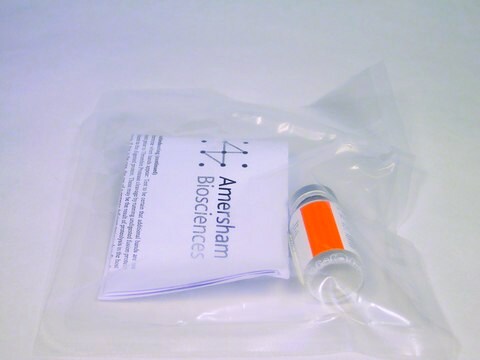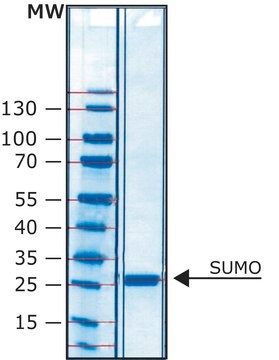GS59
GST M5-5, Recombinant Human
Sinonimo/i:
glutathione S-transferase mu 5
Autenticatiper visualizzare i prezzi riservati alla tua organizzazione & contrattuali
About This Item
Codice UNSPSC:
12352200
NACRES:
NA.55
Prodotti consigliati
Origine biologica
human
Livello qualitativo
Ricombinante
expressed in E. coli
Saggio
>95% (SDS-PAGE)
Stato
frozen liquid
Attività specifica
183.9 units/mg protein
PM
27.4 kDa
Concentrazione
3.2 mg/mL
Temperatura di conservazione
−70°C
Informazioni sul gene
human ... GSTM5(2949)
Descrizione generale
using spectrophotometric determination of 1-chloro-2,4-dinitrobenzene (CDNB) conjugation with reduced glutathione (1 mM) in 100 mM NaPO4 (pH 6.5) at room temperature.
Azioni biochim/fisiol
Glutathione S-transferase mu 5 (GSTM5) is an enzyme that in humans is encoded by the GSTM5 gene. Glutathione S-transferases (GSTs) are a family of enzymes that play an important role in detoxification by catalyzing the conjugation of many hydrophobic and electrophilic compounds with reduced glutathione. Based on their biochemical, immunologic, and structural properties, cytosolic and membrane-bound forms of glutathione S-transferase are encoded by two distinct supergene families. At present, eight distinct classes of the soluble cytoplasmic mammalian glutathione S-transferases have been identified: alpha, kappa, mu, omega, pi, sigma, theta and zeta. The GSTs are thought to function in xenobiotic metabolism and play a role in susceptibility to cancer, and other diseases.
The GSTM5 gene encodes a glutathione S-transferase that belongs to the mu class. The mu class of enzymes functions in the detoxification of electrophilic compounds, including carcinogens, therapeutic drugs, environmental toxins and products of oxidative stress, by conjugation with glutathione. The genes encoding the mu class of enzymes are organized in a gene cluster on chromosome 1p13.3 and are known to be highly polymorphic. These genetic variations can change an individual′s susceptibility to carcinogens and toxins as well as affect the toxicity and efficacy of certain drugs. Diversification of these genes has occurred in regions encoding substrate-binding domains, as well as in tissue expression patterns, to accommodate an increasing number of foreign compounds.
Stoccaggio e stabilità
The enzyme should be used by the end-user customer within 1 year of receipt.
Codice della classe di stoccaggio
10 - Combustible liquids
Classe di pericolosità dell'acqua (WGK)
WGK 1
Punto d’infiammabilità (°F)
Not applicable
Punto d’infiammabilità (°C)
Not applicable
Scegli una delle versioni più recenti:
Certificati d'analisi (COA)
Lot/Batch Number
Non trovi la versione di tuo interesse?
Se hai bisogno di una versione specifica, puoi cercare il certificato tramite il numero di lotto.
Possiedi già questo prodotto?
I documenti relativi ai prodotti acquistati recentemente sono disponibili nell’Archivio dei documenti.
Variation in the GST mu locus and tobacco smoke exposure as determinants of childhood lung function.
Carrie V Breton et al.
American journal of respiratory and critical care medicine, 179(7), 601-607 (2009-01-20)
The glutathione S-transferases (GSTs) are important detoxification enzymes. To investigate effects of variants in GST mu genes on lung function and assess their interactions with tobacco smoke exposure. In this prospective study, 14,836 lung function measurements were collected from 2,108
Y V Patskovsky et al.
Biochemistry, 38(49), 16187-16194 (1999-12-10)
The hGSTM3 subunit, which is preferentially expressed in germ-line cells, has the greatest sequence divergence among the human mu class glutathione S-transferases. To determine a structural basis for the catalytic differences between hGSTM3-3 and other mu class enzymes, chimeric proteins
Ying Wang et al.
Journal of human genetics, 55(8), 490-494 (2010-05-21)
Coronary atherosclerosis is a complex and progressive condition that involves many biological pathways, including the oxidative stress and inflammatory response pathways. To investigate the association between common genetic variation within these two pathways and coronary atherosclerosis, we performed a comprehensive
Christian Delles et al.
Journal of hypertension, 26(7), 1343-1352 (2008-06-14)
Glutathione S-transferases are involved in defences against oxidative stress. We have recently demonstrated reduced expression of glutathione S-transferase mu type 1 (Gstm1) in a rat model of hypertension. Here, we examine the association between GSTM variants and hypertension in human.
Ann M Moyer et al.
Cancer epidemiology, biomarkers & prevention : a publication of the American Association for Cancer Research, cosponsored by the American Society of Preventive Oncology, 19(3), 811-821 (2010-03-05)
Lung cancer is commonly treated with platinum compounds. The "glutathione pathway" participates in the metabolism of platinum compounds. We set out to test the hypotheses that single nucleotide polymorphisms (SNPs) or copy number polymorphisms for genes within the glutathione pathway
Il team dei nostri ricercatori vanta grande esperienza in tutte le aree della ricerca quali Life Science, scienza dei materiali, sintesi chimica, cromatografia, discipline analitiche, ecc..
Contatta l'Assistenza Tecnica.








